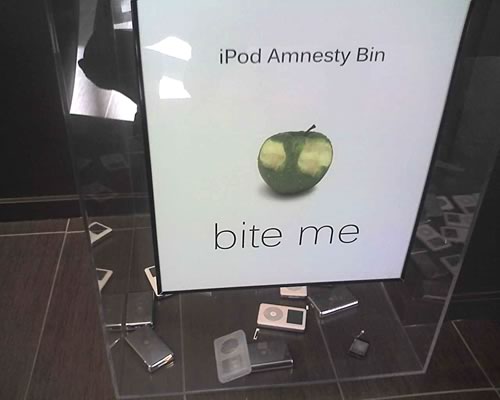
Back during those heady dot-com days, George and I worked for OpenCola, a start-up that was spending US$40,000 a month on the services of a PR firm that shall remain unnamed. I got the feeling that OpenCola was getting more PR bang for the buck from me and OpenCola founder/Chief Evangelist Cory Doctorow. We were based in the San Francisco office, pressing the flesh with as many geeks and tech press as we possibly could, and we had a much better idea of what OpenCola could do than the people to whom we were shoveling 40 grand a month.
I suggested that we could cut our PR budget by having me and Cory holding a monthly “chicken run” a la Rebel Without a Cause. We could jump into a cheap used car with the OpenCola logo plastered all over it, and drive it towards a cliff, bailing out at the last second. Spectacular, far cheaper than the PR farm, and by the standards of those days, a not-too-harebrained publicity stunt. Like any good idea in those days, it was ignored.
My dot-com era experiences have caused me to generally have a dim view of PR firms and the people who work for them — my feelings run the gamut from “necessary evil” to “waste of space” to “waste of ammo” (and sometimes “waste of skin”). The book Toxic Sludge is Good for You has only served to reinforce this opinion.
Hence I cannot help reading Guy Kawasaki’s blog entry, The Top Ten Reasons Why PR Doesn’t Work with a jaundiced eye. Guy could’ve saved me valuable seconds by boiling his list down to the single opinion from which it stems: It’s the client’s fault.
Guy, I’ll see your list of 10 items and counter you with a simple two-item list as to why PR doesn’t work:
- PR companies suck.
- PR companies are stupid.
Much better, and far truer.
(This pains me. Guy’s one of my role models.)
I far prefer the items in the list provided in the article Top 5 (or 6) reasons PR doesn’t work. if you’re a geek., an article written in response to Guy’s:
- The PR firm doesn’t understand the product or technology.
- The PR firm is seen as a spinner, blocker, or gatekeeper to access the CEO/CTO/braintrust.
- The PR firm hasn’t been properly trained on how to communicate with bloggers or social media.
- The PR firm prefers doing a few big traditional media over lots of smaller online media & online channels.
- The PR firm doesn’t understand SEO, SEM, widgets, blogs, tags, social networks, pictures, video, or other online & viral methods, aka “all that Web 2.0 stuff”.
- Most PR folks have no clue what the hell TechMeme is.







